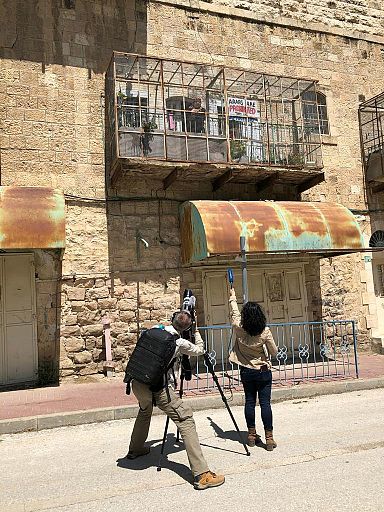What is life like for Palestinian children living in the Israeli-controlled part of Hebron? What's the impact of the conflict on them and what's the role of the EU in reducing their trauma?
Hebron part of the Palestinian territories and it has a unique feature - Israeli settlements are inside the city itself. It is the only city in the West Bank to have both Palestinians and Israelis living so close to each other.
The city was split in 1997 under the Hebron Protocol. It's now divided into two sections: H1, which is under Palestinian control; and H2 which is under Israeli control. Despite being controlled by the Israelis, H2 contains 40,000 Palestinians compared to only 800 Israelis who are protected by 650 Israeli soldiers.
It's in H2 where friction between the two communities happens on a daily basis. Here, entire areas have been closed off to protect Israeli settlers. Shuhada Street, once the Old Town's bustling market, is a "sterile zone" where Palestinians are not allowed to walk, in spite of their houses still being there.
Children are exposed to the conflict
The Palestinian residents of H2 are subject to Israeli military law and this includes children. Arrests of minors are known to take place, even in schools. In March a 9-year-old boy was seized from his school for allegedly throwing stones.
Over 200 children are detained in Israeli prisons, 21 of them are from Hebron with the youngest child arrested last year being six.
Michelle Cicic works for the EU Humanitarian Aid Office:
"According to the UN there is an estimated 38,000 children who are exposed to conflict-related violence in area C, which is the area controlled by the Israeli authorities in Palestinian territory. You have also approximately fifty schools in the same area, area C, that remain at risk of demolition".
"For the EU we believe that education is a basic human right, but also of course because of the impact that the violations are having on children, on the safe access to school".
Getting in the way of education
This friction has a particular effect on children's education. Around 4,200 Palestinian children in Hebron face checkpoints and harassment on their way to school.
Waed is 13 years old and has always lived in the city. Every morning she doesn't know when and if she will be able to reach her class:
"When I go to school every day I face lots of challenges. There are a lot of soldiers there, they search us every day and I arrive systematically late".
With an Israeli settlement across the street, Waed's school gates have a checkpoint in front of them.
Her school is included in the Better Learning Programme, financed by EU Humanitarian Aid and implemented by the Norwegian Refugee Council.
Camilla Lodi, from the Council, spoke about the work they do:
"This year we are targeting 80 schools in the West Bank and in these most vulnerable schools, we find that approximately 20% have been heavily traumatized. The results are really promising because usually on average two-thirds of the children go down from having four nightmares per week to zero nightmares".
In the Programme teachers are trained to provide relaxation exercises which help their students focus. In areas of increased tension like H2, students can be stressed and find it difficult to concentrate on their education.
The Programme also provides learning groups for underachieving students and private or group sessions with counsellors for children with trauma-induced nightmares.
Waed said the Programme helped: "When I started the programme, I learnt how to control my anger and how to overcome challenges. I also got better results at school".












